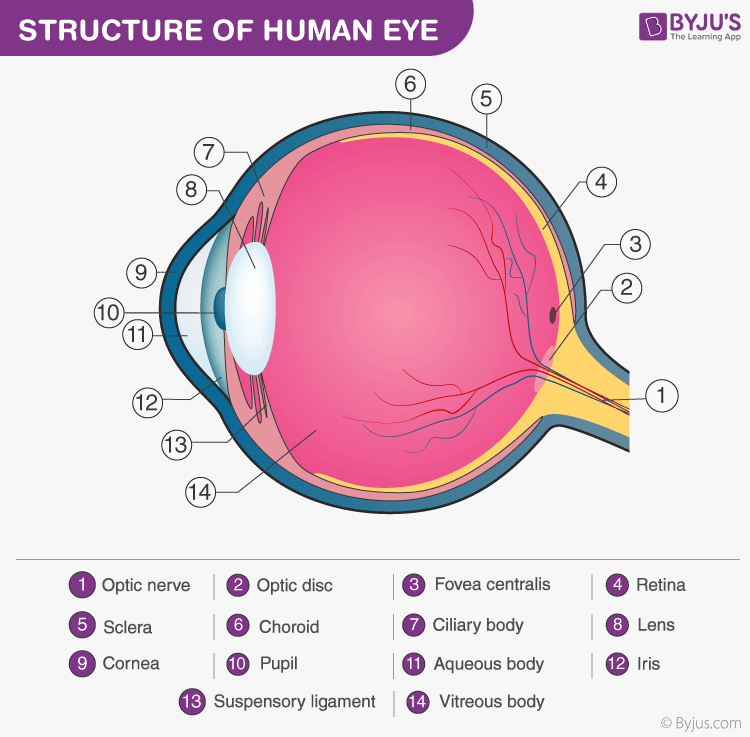Pupil Eye Meaning
Pupil is the black hole seen at the centre of the iris of the eye which permits light towards retina.
Pupil is the opening in the iris of the eye wherein light enters before it reaches the lens and focusing on the retina. The muscles of iris regulate the size of opening. They quickly constrict the pupil when it is exposed to bright light and dilate the pupil when in dim light.
Table of Content:
What is Pupil?
Eye Pupil Meaning
The pupil is the small black circle in the centre of the iris. It is a tiny hole present over the lens through which light enters the eye and focuses on the retina for image formation. The iris muscles regulate the size of the pupil and control the amount of light entering it.

The central opening of the iris is the pupil and it is typically black in colour. The surrounding brown, blue or grey area is called the iris. The outer white area is the sclera.
The pupil usually seem perfectly round in shape and black in colour and equal in size. The black colour is as a result of light passing through the pupil which is absorbed by the retina and not being reflected back.
Also Explore:
| What is the function of iris? |
| What is the sclera of eye? |
Pupil – Function
The pupil is black because all the light that goes inside gets absorbed by the retina. It is like an aperture of the camera. There are two types of iris muscles that control the size of the pupil. They are:
- Circular sphincter pupillae – constricts pupil on contraction
- Radial dilator pupillae – dilates pupil on contraction
This is called the pupillary light reflex, which controls the diameter of the pupil and controls the light intensity entering the pupil. It responds to the light striking ganglion cells present in the retina at the posterior part of the eye. The pupil dilates in dim light and constricts under bright light. This way it protects the lens and retina from damage from high light intensity and also allows us to see clearly under dim conditions.
The colour of the pupil becomes pale yellow when the lens becomes opaque or cloudy in case of cataract.
What is the size of the Pupil?
From person to person, the size of the pupil differs. In some it is small and in some it is large; it also varies with age wherein young adults tend to have a bigger pupil.
Typically, the normal size of the pupil’s diametre in adults range between 2 and 4 millimetres in bright light and in the dark it ranges from 4 to 8 millimetres.
Pupils usually constrict while being affected by light when focused on a object nearby. This is referred to as the accommodative pupillary response.
Dilated Pupil
The muscles of the iris govern the size of the opening. They instantly constrict upon exposure to bright light and dilate the pupil when in dim light. The parasympathetic nerve fibres arising from the third cranial nerve innervate the muscles which induce the constriction of the pupil. On the other hand, the sympathetic nerve fibres regulate the dilation. The pupillary aperture in addition, channels while focusing on objects nearby and dilates when viewing objects at a distance.
Pupils change their size to permit less or more light to the eyeball. Such movements are not in control, they are involuntary. They are under the control of the autonomic nervous system. The dilation of the pupil increases the size of the pupil thus permitting more light to pass through it which takes place in situations where there is low light. This occurs by the action of the dilator pupillae muscle which are regulated by the symapathetic nervous system.
This was in brief about Pupil. Test your understanding with MCQs on Structure of Eye, only at BYJU’S.
Related Articles:
| Sensory Receptors |
| Process of Neural Communication |
| NEET Biology Flashcards – Neural Control and Coordination |
Frequently Asked Questions
What is pupil?
What is the shape of pupil?
In humans, the pupil is a small black circle in the centre of the iris. It is typically round but its shape varies with species. Some reptiles, foxes and cats have vertical slit pupils.
What determines the pupil size?
There are two types of iris muscles that control the size of the pupil. The circular sphincter pupillae constricts the pupil on contraction and the radial dilator pupillae dilates the pupil on contraction.


Comments